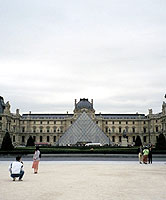Louvre Museum

In May of 2005 ITV reported that The Lourve has granted the production team behind 'The Da Vinci Code' to film at the historic museum.
 The Louvre was not in any way originally intended to become a museum. The "salle des antiques" which Henri VI set up on the ground floor of the Grande Galerie was not accessible to the general public, nor was the king's cabinet of drawings, created in 1671, or the king's cabinet of paintings, to which access was reserved for a privileged few.
The Louvre was not in any way originally intended to become a museum. The "salle des antiques" which Henri VI set up on the ground floor of the Grande Galerie was not accessible to the general public, nor was the king's cabinet of drawings, created in 1671, or the king's cabinet of paintings, to which access was reserved for a privileged few.From the date when, under Louis XIV, most of its occupants left the Louvre, its vocation as a "palace of the arts" appeared a quite natural progression in the eyes of the resident artists and the academies. The idea of a Palace of the Muses or "Muséum", where one could view the royal collections, was born in 1747. The museum concept, which was quite new at the time, ran along the same lines as the Encyclopedia and the philosophy of the Enlightenment. From 1779, purchases and museographical projects demonstrate the imminence of its realisation.
 The Second Republic and the Second Empire pursued the same policy. The museum, more of which was opened to the public, continued to extend its collections and to add new areas, such as those of the Etruscans, Archaic Greece and the Ancient Orient.
The Second Republic and the Second Empire pursued the same policy. The museum, more of which was opened to the public, continued to extend its collections and to add new areas, such as those of the Etruscans, Archaic Greece and the Ancient Orient.Napoleon III commissioned the architect Visconti to complete the Palace. Hector Lefuel, who succeeded him on the site, led the work and imposed his ideas in an excessive and self-opinionated manner. The section which separated the two palaces was torn down, symmetrical blocks enclosed the new cour Napoléon, the façades were covered with a riot of decoration and the North wing closed off the whole unit. The Nouveau Louvre, which was inaugurated in 1857, finally completed the "Grand Dessein" or Grand Design. Transformations which were completed in 1869 changed the appearance of the South-West wing.
The benefit of these efforts was enjoyed for only two years, since the palais des Tuileries was destroyed by fire in 1871.
 In 1882, after twelve years of projects and of beating about the bush, the demolition of the Tuileries ruins put an end to the building's palatial function. But Lefuel rebuilt the "Pavillon de Flore" and "Pavillon de Marsan" blocks and the North wings, which housed the Finance Ministry. The history of the Louvre Palace henceforth became linked to that of the Museum.
In 1882, after twelve years of projects and of beating about the bush, the demolition of the Tuileries ruins put an end to the building's palatial function. But Lefuel rebuilt the "Pavillon de Flore" and "Pavillon de Marsan" blocks and the North wings, which housed the Finance Ministry. The history of the Louvre Palace henceforth became linked to that of the Museum.Once again, its appearance was altered with new decorations, for example the great staircase (1934), which is now dominated by the Winged Victory of Samothrace, the antichamber of Henri II, the ceiling of which is adorned with a composition by Georges Braque (1953). As a national museum, the Louvre has continued through the XXth century to enrich its collections and to display them to advantage.
But by the seventies, the available space was not longer able to cope with the growing collections and with the public popularity of the museum. A radical solution was needed. Thus most of the post 1848 work was transferred in 1986 to the musée d'Orsay, which was created on the opposite bank of the Seine, and renovation work began on the Louvre itself.
Everything has been designed in such a way as to allow as many members of the public as possible to gain access to the museum. A welcoming reception and a pleasant visit have been prime factors. In the Auditorium, the public are offered concerts, lectures and films.
By rethinking its function as a museum, the Louvre Palace has rediscovered a rich and animated life at the heart of the city.
The "Grand Louvre" constituted the realisation of an earlier project, which involved devoting the entire Palace to the function of a museum, whilst modernising and improving the presentation of the collections.
Covering an area of some 40 hectares right in the heart of Paris, on the right bank of the Seine, the Louvre offers almost 60,000 m² of exhibition rooms dedicated to preserving items representing 11 millennia of civilisation and culture. The "Grand Louvre" is also a cultural unit which has a didactic role towards the public, a role which it fulfils through lectures, audiovisual and interactive productions and very many printed publications which are available in the exhibition rooms or at the bookshop under the pyramid.
0 Comments:
Post a Comment
<< Home